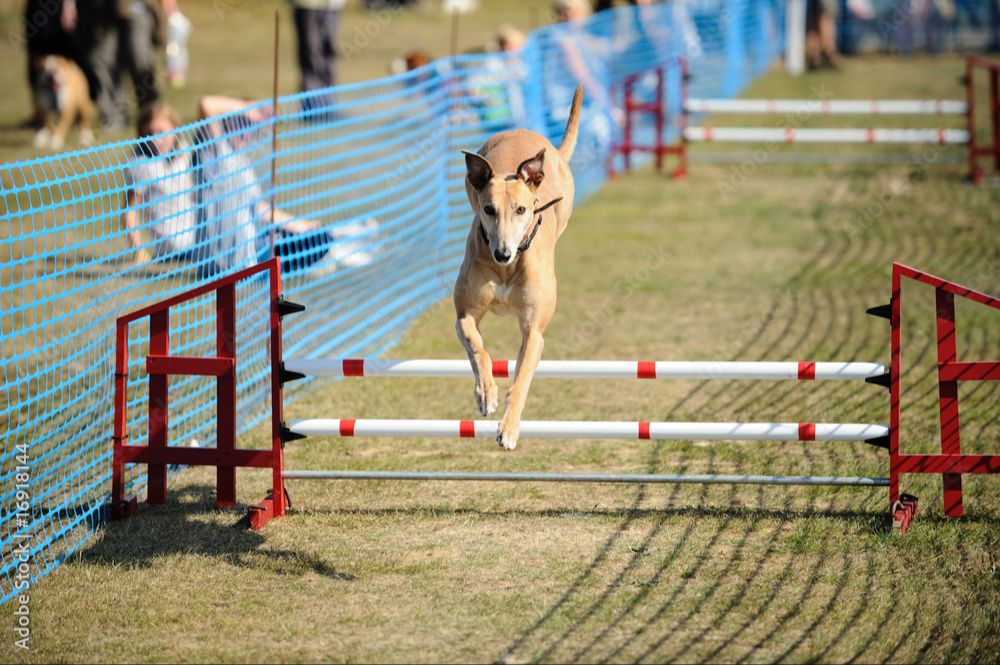Introduction
Dogs are amazing animals capable of feats that can seem almost superhero-like to us humans. One impressive skill that certain breeds have become known for is their ability to jump to astounding heights. While the average dog can jump around 3-4 feet, some breeds like the Belgian Malinois and Australian Kelpie can vertically leap 5-6 feet or more – that’s higher than most people! What allows these agile canines to practically fly through the air? It’s a combination of powerful, well-developed muscles, athletically built bodies, and jumping that’s ingrained in their breed. In this article, we’ll explore some of the highest jumping dogs, the anatomy that gives them a leg up, world record holders, training tips, health considerations, and fun facts about these gravity-defying furry friends.
Breeds Known for Jumping
Certain dog breeds are known for their incredible jumping ability due to their breeding history and physical attributes. Some of the top jumping breeds include:
Greyhounds are one of the highest jumping dog breeds. They are able to jump up to 5 feet high from a standing position. This is due to their lean body, large hind legs, and history of being bred for racing and coursing game.
Belgian Malinois are energetic working dogs that can jump up to 6 feet high. Their strong hindquarters allow them to leap very high. This jumping ability made them excellent herding dogs.
Border collies are agile herding dogs capable of jumping 4-5 feet high from a standstill. Their athleticism and drive to work makes them excellent jumpers. Border collies also possess long hind legs built for exploding up into the air.
Anatomy Behind Jumping
A dog’s anatomy has evolved specifically for jumping and leaping. Powerful muscles in the hind legs, flexible joints, and a supple spine all enable dogs to jump to remarkable heights. The main jumping muscles are located in the thighs and lower legs, including the quadriceps, hamstrings, gastrocnemius, and soleus muscles (K9 Fit Solutions, 2022). These muscles provide the explosive power needed for vertical lift.
When a dog prepares to jump, it crouches down, flexing the ankle, knee, and hip joints while engaging the core muscles. This stores elastic energy and allows the dog to propel upwards powerfully. At takeoff, the hind legs drive forward as the dog fully extends the joints, providing momentum and lift. The front limbs help absorb impact on landing (Clothier, n.d.).
A flexible spine is also critical for jumping. The thoracic and lumbar vertebrae compress on takeoff, then extend and flex to drive the hindquarters upward while maintaining stability through the air. Intervertebral discs cushion the vertebrae and prevent injury. Together with strong leg muscles, this spinal mobility gives dogs their remarkable leaping ability (K9 Fit Solutions, 2022).
Training High Jumping
Teaching a dog to jump high requires patience and positive reinforcement through target training and repetition. Start by holding a treat above the dog’s head and giving the verbal cue “jump!” Reward the dog when it jumps up, even if it’s just a little hop. Slowly increase the height over multiple training sessions until the dog is consistently jumping as high as desired.
Lures can also help guide the dog’s motion upwards. Attach treats or a toy to a stick or pole and hold it above the dog’s head, slowly raising it as the dog jumps higher. Always give strong praise and treats when the dog succeeds. With enough practice, most dogs can learn to reliably jump several feet in the air on command. Target platforms like low hurdles or boxes can provide milestones during training. Work up to running jumps by having the dog jump over progressively higher obstacles.
Take care not to push dogs too far too fast, as this can risk injury. Allow adequate rest time between training sessions. High jumping requires significant effort and should only be done once dogs are physically mature, around 1-2 years old. Always monitor dogs closely for signs of fatigue, soreness or unwillingness to participate.
Sources:
https://www.wikihow.com/Teach-Your-Dog-to-Jump
World Record Holders

The highest jump by a dog ever recorded is an astounding 75.5 inches, achieved by a greyhound named Feather in 2017, according to the Guinness World Records. Feather jumped this world record height under the instruction of her owner John Brant, a professional dog trainer. Greyhounds are one of the breeds known for their incredible jumping abilities, with their lean build and long legs built for speed and agility.
Another top world record holding dog is a Belgian Malinois named Cinderella May J, owned and trained by the Boldog Kennel in Hungary. Cinderella set the record for the highest jump cleared by a dog in the high jump category, leaping over a bar set at 68 inches in 2017, according to the Guinness World Records. The high jump requires a dog to leap straight up and clear a bar set at various heights without knocking it off.
A Jack Russell Terrier named Royal also holds an impressive world record for the longest jump by a small dog, achieved in 2015. Royal jumped an incredible 11 feet and 3 inches, which is more than twice his own height, as verified by the Guinness World Records. He likely leveraged his muscular rear legs and energetic nature that the Jack Russell Terrier breed is known for.
Tricks Using Jumping
Dogs can be taught a variety of fun and challenging tricks that utilize their jumping abilities. Some popular jumping tricks include:
- Hurdle jumping – where the dog jumps over progressively higher hurdles. This is a key component of agility and other dog sports.
- Disc fetching – where the dog jumps up to catch a flying disc in the air. This is the basis for disc dog competitions.
- Hoop jumping – where the dog jumps through a hoop being held at different heights and distances.
- Long jumping – where the dog is taught to leap as far forward as they can over a marker on the ground.
- High jumping – where the dog jumps up to “high five” or touch an object being held above their head.
These types of jumping tricks are excellent forms of exercise and mental stimulation for athletic dog breeds. They also help strengthen a dog’s hind legs and improve their overall fitness. With positive reinforcement training methods, most physically capable dogs can be taught to perform impressive jumping tricks.

Health Considerations
Jumping, especially repeatedly and from high heights, can potentially lead to joint problems and injuries in dogs. The constant impact on their joints from landing can cause issues like arthritis, tendon and ligament tears, cartilage damage, and other orthopedic injuries over time.
According to veterinarians, the biggest health threat linked to jumping in dogs is early onset arthritis. Studies show that as many as 65% of dogs develop arthritis at some point in their lives, and repeated high impact jumping and landing can contribute to this. Jumping puts significant stress on joints and causes inflammation, leading to degenerative joint diseases. Landing on hard surfaces is especially tough on joints versus grass or carpet.
Obesity can also exacerbate joint problems in dogs that jump frequently. The extra body weight adds pressure to joints and causes additional impact on landing. Keeping dogs at a healthy weight is important to minimize strain on joints from jumping and other activities.
While some dogs may genetically have stronger joints and connective tissues, it’s important to be mindful of a dog’s age, breed predispositions, weight, and joint health when allowing them to jump. Consulting with a veterinarian can provide guidance on safe frequencies and heights for an individual dog’s jumping based on their specific health profile.
Precautions
It takes extensive training for dogs to be able to jump as high as buildings. Owners of high jumping dogs need to be aware of certain precautions to keep their pets safe.
High jumping puts a lot of strain on a dog’s joints and muscles. Owners should consult with a veterinarian to monitor for signs of injury and ensure the dog stays in good health (1). Proper warm-ups, conditioning, and cooldowns before and after high jumping can help reduce risk of strains and sprains.
Dogs should only practice jumping under the owner’s supervision. Unmonitored high jumping could lead to risky behavior and injuries. Owners need to set clear rules and boundaries for when and where jumping is allowed.
High jumps should always be attempted onto safe, cushioned surfaces. Hard surfaces like concrete greatly increase odds of injury from impact. Grass, sand pits, and padded mats or foam are safer alternatives (2).
Beginner high jumping dogs should start low and incrementally work up height as their skills progress. Attempting maximum heights too soon can overwhelm the dog’s abilities. Go slow with plenty of positive reinforcement.
While impressive, owners should discourage dogs from jumping onto people or furniture. This could lead to accidental scratches or knockdowns. Well-trained dogs will wait for cues before attempting high jumps.
With proper precautions, high jumping dogs can showcase their skills safely and avoid injuries. Their athletic feats require planning and care to pull off responsibly.
Sources:
(1) https://www.humanesociety.org/resources/how-stop-your-dog-jumping
(2) https://www.akc.org/expert-advice/training/how-to-stop-your-dog-from-jumping-up-on-people/
Fun Facts
Here are some interesting trivia and statistics about high jumping dogs:

The current world record for the highest jump by a dog is held by a greyhound named Coby who jumped an impressive 6 feet 9 inches in 2017 (source).
Border collies consistently rank as one of the top jumping breeds. The highest recorded jump by a border collie is over 5 feet high.
It’s estimated that the average dog can jump somewhere between 4-5 times their height. So a dog that is 1 foot tall may be able to jump up to 4 feet!
Smaller dogs like Papillons and Shetland Sheepdogs can jump many times their height thanks to their athleticism and agility.
Some sources estimate that agility trained dogs like border collies can jump up to 8 times their height!
Herding breeds tend to be great jumpers since they are bred to jump high to control livestock. This includes breeds like Australian shepherds and Belgian Malinois.
Police and military dogs are often selected for their jumping ability, with some able to leap tall chain link fences from a standstill.
It’s important not to overwork young puppies as their growth plates are still developing. Jumping should be built up slowly in dogs under 1 year old.
Conclusion

Jumping is an impressive skill that certain dog breeds have become known for based on their anatomy, abilities, and training. While some dogs like Greyhounds and Belgian Malinois can leap several feet in the air to clear high obstacles with ease, most dogs will never jump higher than a few feet off the ground. The world record for the highest jump by a dog is currently held by a Greyhound named Cinderella May, who jumped an astonishing 5 feet 5 inches.
While high jumping tricks may seem entertaining, owners should use caution and moderation when training dogs to jump, as it can lead to joint injuries if practiced excessively. Setting reasonable limits and providing proper conditioning is key to keeping a dog healthy while developing their natural jumping talent. When done carefully, teaching a dog to jump can be a fun way to exercise them both physically and mentally. Just be sure to celebrate their efforts, not just the heights they achieve.
